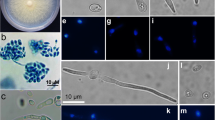Summary
Separate genes conferring antibiotic drag resistance have been inserted into Fusarium graminearum and Fusarium moniliforme. These organisms are associated with stalk rot of corn, a disease of uncertain cause. Antibiotic resistant fungi were obtained by developing a gene transfer system using whole cells as recipients for DNA. Hygromycin B and benomyl-resistant colonies were isolated by treating fungal tissue with lithium acetate and adding plasmid vectors containing the respective genes which give drug resistance. The DNA was stably integrated into the fungal chromosome. Following plant inoculation, disease symptoms developed and the isolates were recovered on selective medium. In each case, these fungi retained the transformed phenotype, although extensive rearrangements and/or deletions occurred. Specific molecular tagging allows detailed studies of this interaction and should be of general use in situations involving complex multiple pathogen diseases.
Similar content being viewed by others
References
Birnboim HC, Doly J (1979) A rapid alkaline extraction procedure for screening recombinant plasmid DNA. Nucleic Acids Res 7:1513–1523
Chirstensen JJ, Wilcoxson ERD (1966) Stalk rot of corn, Monograph No. 3. The American Phytopathological Society, Worchester/MA
Dhawale SS, Paietta JV, Marzluf GA (1984) A new, rapid and efficient transformation procedure for Neurospora. Curr Genet 8:77–79
Dickman MB (1988) Whole cell transformation of the alfalfa fungal pathogen Colletotrichum trifolii. Curr Genet 14:241–246
Dickman MB, Kollattukudy PE (1987) Transformation of Fusarium solani pisi using the cutinase promoter. Phytopathology 77:1740 (Abst.)
Hanahan D (1983) Studies on transformation of Eschericia coli with plasmids. J Mol Biol 166:557–580
Hynes MJ (1986) Transformation of filamentous fungi. Exp Mycol 10:1–8
Ito H, Fukuda Y, Murata K, Kumura A (1983) Transformation of intact yeast cells treated with alkali cations. J Bacteriol 153:163–168
Kaster KR, Burgett SG, Rao RN, Ingolia TD (1983) Analysis of a bacterial hygromycin B resistance gene by transcriptional and translational fusions and by DNA sequencing. Nucleic Acids Res 11:6895–6911
Kaster KR, Burgett SG, Ingolia TD (1984) Hygromycin B resistance as dominant selectable marker in yeast. Curr Genet 8:353–358
Kommedahl T, Widels CE (1981) Root-, stalk-, and earinfecting Fusarium species on corn in the USA. In: Nelson PE, Toussoun TA, Cook RJ (eds) Fusarium: Disease, biology and taxonomy. Pennsylvania State University Press, University Park, pp 94–103
Kommedahl TC, Windeis CE, Stucker RE (1978) Occurrence of Fusarium species in roots and stalks of symptomless corn plants during the growing season. Phytopathology 69:961–966
Lengkeek VH (1979) Stalk rots of corn and sorghum. Kansas State Univ Coop Exten Serv Pub No AF-46
Mandel M, Higa A (1970) Calcium dependent bacteriophase DNA infection. J Mol Biol 53:154–157
Maniatis T, Fritsch EF, Sambrook J (1982) Molecular cloning: a laboratory manual. Cold Spring Harbor Laboratory Press, Cold Spring Harbor/NY
Marshall MR, Partridge JE (1981a) Immunochemical identification of Fusarium moniliforme ribosomes from diseased corn stalk tissue. Physiol Plant Pathol 19:277–288
Marshall MR, Partridge JE (1981b) Fusarium moniliforme detection in corn (Zea mays L.) stalk tissue: Identification of specific ribosomal proteins log polyacrylamide gel electrophoresis. Physiol Plant Pathol 18:133–141
Neff NF, Thomas JH, Grisafi P, Botstein D (1983) Isolation of the β-tubulin gene from yeast and demonstration of its essential function in vivo. Cell 33:211–219
Orbach NJ, Porro EB, Yanofsky C (1986) Cloning and characterization of the gene for β-tubulin from a benomyl-resistant mutant of Neurospora crassa and its use as a dominant selectable marker. Mol Cell Biol 6:2452–2461
Raeder V, Broder P (1985) Rapid preparation of DNA from filamentous fungi. Lett Appl Microbiol 1:17–20
Rigby PWJ, Dieckmann MK, Rhodes C, Berg P (1977) Labeling deoxyribonucleic acid to high specific activity in vitro by nick translation with DNA polymerase 1. J Mol Biol 113:237–251
Rodriguez RJ, Yoder OC (1987) Selectable genes for transformation of the fungal plant pathogen Glomerella cingulata f. sp. phaseoli (Colletotrichum lindemuthianum). Gene 54:73–80
Southern EM (1975) Detection of specific sequences among DNA fragments separated by gel electrophoresis. J Mol Biol 98:503–517
Turgeon BG, Garber RC, Yoder OC (1987) Development of a fungal transformation system based on selection of sequences with promoter activity. Mol Cel Biol 7:3297–3305
Vollmer SJ, Yanofsky C (1986) Efficient cloning of Genes of Neurospora crassa. Proc Natl Acad Sci USA 83:4869–4873
Wang J, Holden DW, Leong SA (1988) Gene transfer system for the phytopathogenic fungus Ustilago maydis. Proc Natl Acad Sci USA 85:865–869
Young HC, Jr (1943) The toothpick method of inoculating corn for ear and stalk rots. Phytopathology 33:16
Author information
Authors and Affiliations
Additional information
Communicated by G. S. Khush
Rights and permissions
About this article
Cite this article
Dickman, M.B., Partridge, J.E. Use of molecular markers for monitoring fungi involved in stalk rot of corn. Theoret. Appl. Genetics 77, 535–539 (1989). https://doi.org/10.1007/BF00274275
Received:
Accepted:
Issue Date:
DOI: https://doi.org/10.1007/BF00274275




